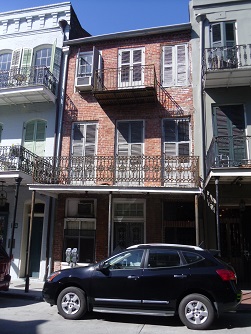Tear Downs and Out-of-Scale Replacement Homes

Last Updated: May 30, 2022
All across the country, tear downs are a relatively new phenomenon. This is where the house is acquired only to be torn down to allow erection of a new, larger house. The phenomenon was fading during the 2009 Great Recession and its aftermath, but it has reappeared in many parts of the country and world.
We have a feeling that people aren't quite cured of their desire for a great big house.
It happens usually in neighborhoods that are close to valuable commercial areas or other newly prosperous residential areas, or maybe near major universities, hospitals, or large employers that pay good salaries. Smaller houses in good repair are being purchased and demolished, for the sole purpose of erecting a much more elaborate house.
Some call the new houses McMansions or monster houses. At any rate, houses much larger than those currently in the neighborhood are being built on newly vacant lots.
And often the tear downs were perfectly decent homes situated in a nice location. Redevelopment and upgrading the housing stock to appeal to the current market are admirable goals. A government or a large developer may have a very sound reason for doing such a thing within the confines of a market economy.
But here we're talking about opportunists buying individual parcels to do tear downs and over-build. Below we'll outline several courses of action for a person or community organization concerned about tear downs in a particular neighborhood.
• Learn your facts. Find out whether one developer is responsible, or whether a variety of apparently unconnected persons are engaging in this activity. If one or a few persons predominate, try to meet with them to learn their intentions.
Pay attention to why they think your neighborhood is such a hot commodity, listen for a strategy, and probe to find out any motivation other than sheer profitability.
• Next learn the attitudes of your public officials. They may well think the tear downs are absolutely wonderful. After all, it means their location is popular, and their property tax base is soaring. They now have "bragging rights," and people don't get into politics without some ego.
• Also talk to any city planners that may be employees or consultants to your community. What do they think of what's happening? Are there any ways to use the zoning ordinance or the comprehensive plan (sometimes called a master plan, a land use plan, housing plan, or policy statement) to argue against the tear downs?
After all, zoning began as a way of assuring that light and air were available to tenement houses in New York City, but with the tear down phenomenon, neighbors are have less access to the morning sunlight and evening breezes that they have enjoyed all these years!
• Appeal to rationality. Point out that good urban design of residential areas usually includes a somewhat uniform setback from the street, and that similar heights, building materials, and architectural approaches along the face of a block are usually considered strengths. This won't deter the developer who has designs on an entire block, but it may carry some weight with public officials, planning staff members, and design-sensitive residents.
• Ask why it is suddenly fine for a street to include houses twice or three times the typical size, two stories or even two and a half compared to the typical one-story, with absolute minimum side yard setback.
• Point out that the net effect is that a perfectly fine home appears to be dwarfed, and is actually diminished in value because the homeowner no longer has the air, light, circulation, and feeling of openness outdoors previously enjoyed.
• After being rational, ask if the city government is prepared to compensate homeowners for losses incurred due to their lack of vigilance about the situation, or whether they prefer to enact sensible regulations that would halt this unjust progression.
• Face facts and act accordingly. You need to assess, with the help of any urban planning, architecture, or design professionals you know, whether the tear downs have gained too much of a foothold for any remedial steps to be really practical. As you can readily see, if the tear downs become the predominant factor, then it will become the smaller, older homes that are out of step with the design of the neighborhood.
If you have not waited until too late to act, the most important weapon against tear downs and monster houses lies within the regulations pertaining to zoning districts. Look at lot coverage, yard setback, height, lot coverage, and floor area ratio (FAR) requirements.
A new floor area ratio probably needs to be enacted to help regulate what planners call the bulk of the new houses. A floor area ratio is the maximum allowable ratio between the sum of all floor areas (so twice the building footprint in the case of a two-story house) to the area of the lot.
Most zoning ordinances include a maximum lot coverage percentage, which is a similar idea, but it pertains only to the percentage of the total lot that the building footprint requires. So it doesn't address the two-story or three-story part of the problem.
Also a government could consider simply maximum square footage regulations for new construction. The precedent would be that some ordinances have long determined the required front yard setback by averaging the front yard setbacks of the other homes on the block.
Any changes should be considered carefully and written narrowly to cover the minimum area possible. Over-reacting could stomp on the brakes of the housing market too hard.
Try to avoid remedies that will result in large-scale rezonings of much of the town. To create a new zoning classification and assign much of the town to that district, the government will have to go through expensive and labor-intensive notifications and public meetings. This surely will meet with resistance from the leaders.
So try to propose modest zoning regulation changes to existing districts. (Some city attorneys still will rule that a change that affects all property owners in a district requires notices to be sent to all, but a targeted approach will result in far less need for expensive notification.)
Note that we have not proposed any way to prohibit the tear downs. It's the inappropriate new infill housing that can be prohibited.
Sample Housing Tear-Down Remedies to Discuss
Below are sample ordinance changes to discuss, although in no way are these numbers the correct magic numbers. Appropriate numbers will be found by looking at your existing housing stock and allowing only slight variations from what is now typical.
- If more than 75% of the homes on the block face are one-story homes, the maximum height of an infill home shall be no more than two stories, or 28 feet, whichever is less. Or be bold and go for 14 feet.
- If an infill home adjoins an existing one-story home, the side yard requirement for any two-story home to be built on adjoining property within the same block shall be doubled.
- No infill home to be built within this zoning district shall exceed 125% of the average square footage of finished space in the existing homes on the block, excluding basement spaces.
- The floor area ratio in single-family zoning district SF shall not exceed 0.6:1.
Like enacting any zoning ordinance amendment, it's important to include an explanation of intent. If you convince your City Council to change the ordinance, make sure they provide some "legislative intent" language about preserving the bungalow style in Mountain View, maintaining a conservation district of 19th century homes, or regulating the disappearance of affordable housing, as examples. Refer to any supportive language in your comprehensive plan.
A court later would review the legislative intent language in considering whether the new regulation was too restrictive.
Now here's where reality hits. Is your neighborhood too populated with monster houses to go backward?
If there is no realistic way that the neighborhood can "look right" again, perhaps your best option is to join the sellers and find yourself a new neighborhood. That's a tough option, but it may be the best option if there are several large houses already built.
Realistically, no City Council is going to require the new investments to be demolished, unless they were erected illegally. (Even then, the odds are against you; they are much more likely to be legalized somehow than to be required to be torn down.)
If you decide to stay, try to salvage the urban design by introducing a uniting element of streetscape at the sidewalk or street.
For example, a new line of street trees can soften the impact of the varying home heights considerably and add an element of uniformity. Or try uniform mailboxes or planter boxes. Any distraction from the "Mutt and Jeff" look of the McMansions next to the smaller houses will be helpful.
As a last resort, if you cannot defeat the huge replacement house phenomenon, you might want to try for some inclusionary zoning to allow two or three housing units to be incorporated within the footprint and mass of a typical large home similar in feeling to the new ones being constructed in the neighborhood. At least that would allow for some healthy mixing of income levels within the neighborhood.
Check Out These Related Pages on the Site
Join USEFUL COMMUNITY PLUS, which provides you monthly with short features or tips about timely topics for neighborhoods, towns and cities, community organizations, rural environments, and our international friends. Unsubscribe any time. Give it a try.





